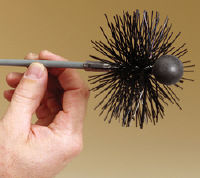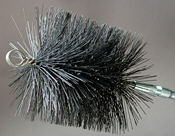 |
| The Buffalo Mountain in the Blue Ride Mts of Southwest Virginia |
With the changing of the leaves, comes the smell of a wood
burning stove in the air. There is nothing like a warm fire on a crisp fall
evening. With that being said, it is time to get your stove in proper working
order (if you haven’t already). A properly maintained chimney is a safe
chimney. Taking the necessary steps to ensure that your stove, stovepipe and
chimney are in good working order will provide you peace of mind.
1. Chimney
inspection
The heart of your heating system is the chimney. A clean and
well maintained chimney is essential to your heating system. Most people
believe that the chimneys’ only purpose is to vent smoke out of the house but
it also allows air to vent into the house, so the value of the chimney cannot
be understated. Be aware that over time the chimney can lose structural
integrity. Examine the chimney for cracks in the mortar. It is common for hairline cracks to be
present but cracks that are larger and/or follow the pattern of the brick may
need to be looked at by professional. Look for brick that has been stained by
the creosote, which should look like a dark black stain running down the
outside of the brick. This indicates that the crack runs through the chimney,
which should be looked by a professional. These cracks may indicate a chimney fire in
the past. Most cracks in chimneys occur in places where the temperature changes
are most extreme (attics, just outside the house, ect.).
2. Flue
inspection
Is everything looking good so far? Let’s move on the flue! A
good chimney has a clean-out door installed at the base of the chimney. This
allows for inspection of the flue and aids in the removal of ash and creosote.
Taking a mirror, stick it into the clean-out door and look into the flue to see if there is any clogs or
deposits. Another issue that occurs is some animals use the flue to build nest
to raise their young. This would be a good time to consider a chimney topper to
prevent animals from entering the chimney. If your chimney doesn’t have a chimney
topper, please click here.
3. Chimney
sweeps
 |
| This pellet stove brush is available in three sizes - 3", 4" and 5" - that all attach to a 5 foot cleaning rod. |
 |
| This round stove pipe chimney brush is available in 6", 7" and 8" sizes here. |
If you are happy with the inspection so far, lets move on to
chimney sweeps. There are many sweeps available for this job. Make sure that a
quality brush is used. There are brushes, extension rods, and other accessories
available here. The
brush should be inserted in the mouth of the chimney (on the roof) and move the
brush up and down the length of the chimney to clear it of creosote. Once all
of the debris is cleaned from the walls of the chimney, go to the clean out
door and remove all the creosote and debris. We a have quality selection of
chimney sweeps.
 |
| This is a woodstove in front of a fireplace has been retrofitted to accommodate woodstove pipe connecting to and properly venting from the chimney. |
Any ashes or debris
that remains should be shoveled out and disposed of. A stiff bristled brush should
be used to remove the excess soot. Inspect the firebrick for cracks and
deterioration. This would be a good time to inspect the internal damper to see
if it moves freely. The damper allows for the warm air to remain inside the
home and not escape outside.
All of the components of the heating system that we have
discussed so far have should have a long life expectancy, however the stove
pipe is not one of those components. Stovepipe should be replaced every three
or four years because the hot gases erode the metal leaving it dangerously thin.
To order replacement stovepipe, please click here. If the stovepipe that you are using is relatively
new, you can take a stiff bristled brush and sweep out the pipe. It is very
important to have the right clearances between the stove, and combustible
material. Keep the stove at least 36 inches away from walls. Set the stove on a
24 gauge steel plate over a wood floor and make sure the plate extends 18
inches beyond where ashes will be removed.
Be sure to buy quality piping from a reliable source and choose stove
pipe that is higher gauge, such as 22 or 24 gauge, than the thinner 26 or 28
gauge varieties. Another last word on stovepipe is to install the pipe with the
male ends pointing downward and to ensure a sturdy hold, fasten the pipe with
sheet metal screws.
Last but not least, we have the wood stove. Remove any ashes
that might be left over from the last fire and examine the interior for cracks,
especially in areas where the wood tends to bang into walls. If the stove has a
catalytic converter, inspect it as described in the owner’s manual. If you do
not have an owner’s manual, contact a reputable stove dealer and order a
manual. Inspect the door of the stove to determine that the door closes tight.
If the door gasket is in good condition, you should be able to feel the door
squeeze firmly against the stove itself when you push it closed and turn the
latch. If the door does not close snuggly, a fiberglass gasket can be used to fix
the problem. If you are interested in installing a gasket in your stove, please
click here.Scrape
the old gasket out of the groove in the door or if the stove does not have a
groove, scrape from around the perimeter of the door. A high temperature
adhesive is used to secure the new gasket to the stove. Whenever the gasket is
glued to the proper areas, close the door of the stove and leave the door
closed tightly for a few hours until the adhesive solidifies. When the adhesive
has cured, your wood-fired heating system is ready to go! With the proper
maintenance, not only will your woodstove provide you warmth and relaxation but
a peace of mind that it will do these things safely. If you require any
additional information, please email us at cs@redhillgeneralstore.com
or call us at (800)-251-8824.
The winter wind…can almost
be soothing. Particularly if one has a healthy hearth.
-Hal Borland



No comments:
Post a Comment